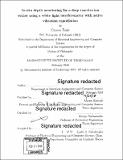In-situ depth monitoring for a deep reactive ion etcher using a white light interferometer with active vibration cancellation
Author(s)
Teale, Carson(Carson Arthur)
Download1102049006-MIT.pdf (17.55Mb)
Other Contributors
Massachusetts Institute of Technology. Department of Electrical Engineering and Computer Science.
Advisor
Martin Schmidt and George Barbastathis.
Terms of use
Metadata
Show full item recordAbstract
Standard process development for micro and nanofabrication etching technologies relies on open-loop trial and error testing of recipes to achieve optimal etch depths and uniformities. This strategy is inefficient for research and fabrication of novel devices where one-of-a-kind experiments cannot justify lengthy process development times. This thesis describes the development of an in-situ depth measurement device for real-time feedback of etch depth and uniformity. This device will help facilitate far shorter process development times, potentially enabling the desired etch to be achieved on the first process run. The depth imager consists of a wide-field, white light interferometer with a 12" working distance, capable of imaging across a 1/2" field of view. Active feedback from a co-propagating laser interferometer is used to stabilize the system against vibrations through a feedback loop that controls the position of the reference mirror using a piezo actuator. This scheme ties the accuracy of the white light depth scan to the stability of the laser wavelength, allowing for accurate step sizes without the need for an expensive scanning stage. The well defined sampling period allows for the phase sensitive detection of the white light interference signal, reducing amplitude fluctuations from plasma emissions. This design is able to image deep trenches with optically rough surfaces, etched directly into a silicon substrate with aspect ratios of 10 or more. The device is demonstrated on a custom built deep reactive ion etcher (DRIE), achieving a depth resolution of better than 1 [mu]m in the presence of large vibrations.
Description
Thesis: Ph. D., Massachusetts Institute of Technology, Department of Electrical Engineering and Computer Science, 2019 Cataloged from PDF version of thesis. Includes bibliographical references (pages 119-121).
Date issued
2019Department
Massachusetts Institute of Technology. Department of Electrical Engineering and Computer SciencePublisher
Massachusetts Institute of Technology
Keywords
Electrical Engineering and Computer Science.